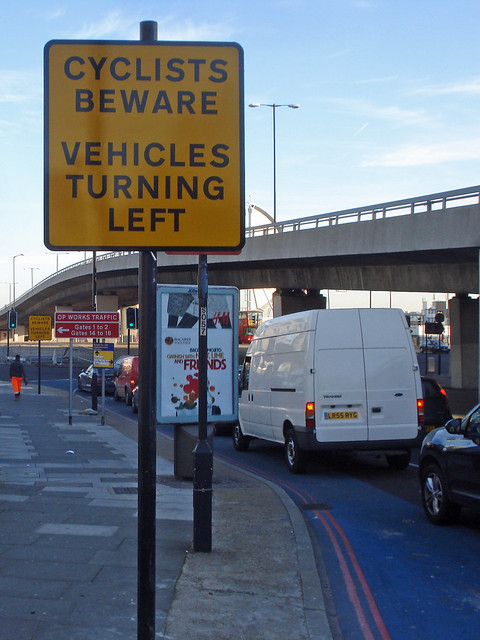The second thing was Diamond Geezer's blog that reported new signs being put up at the notorious Bow Roundabout in London. They include this one.
 | ||
| copyright diamond geezer |
Together, the report and the blog prompted me to return to the data on attributions made in police reports mentioned in Considerate Cycling 5 . They prompted me to reconsider how much the "failing to look" reported by police or the "sorry, mate I didn't see you" (SMIDSY) syndrome might simply be a consequence of what the mobile phone researchers found: normally competent people driving or riding over the limit of their cognitive capacity to stay in full control.
Contemporary roads, especially in and around cities have become much more complex, and more kinds of attention seeking signs and road markings are appearing. As well as the longwinded and somewhat existential message of the notice in Diamond Geezer's lovely snap, notice that there is also a prominent advertisement for Bacardi Rum and three other road signs. (You might need to go to his Flickr account to see the larger versions.)
On top of all the other novelties and complexities, The Department for Transport last year gave the go-ahead to local authorities to start using more road signs in local contexts without the strict controls that have reduced the range of messages and without the legal procedures that have made putting them up more costly. So it looks as though more, and more idiosyncratic, signage is coming our way soon. There will be a lot of people who simply don't know what these signs mean.
I wonder if anyone knows of more specific evidence relevant to my hypothesis? The hypothesis is that there comes a point where signs and markings stop being helpful and start being part of the problem. That point would be a function of the variety, number, novelty and complexity of the signs . Road layouts need to be well designed, and part of the design would call for optimum signage with minimal clutter.
This looks a bit abstract. What would you do once you had seen it?
I suppose the lack of gravity in space would make cycling easier though.

This comment has been removed by a blog administrator.
ReplyDelete